|
Self-Teaching
Unit:
Pronoun Case
©
2006, 2000 Margaret L. Benner All rights reserved.
Before you can begin to study pronoun case, you must first
know what a pronoun is and what the personal pronouns are.
A pronoun is a word that substitutes
for a noun.
Example:

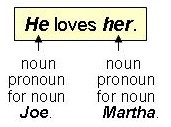
If we reverse the original sentence, it reads:

The nouns’ positions have been reversed, but the forms stay
the same.
Note what happens, however, if we substitute pronouns for
the nouns.

The original pronouns used for the first example (Joe loves
Martha. and He loves her.) CANNOT be used for Martha loves Joe.

RULE:
Correct pronoun case requires different forms of
personal pronouns for different jobs in sentences.
The personal pronouns have 3 cases:
SUBJECTIVE
OBJECTIVE POSSESSIVE
Corresponding forms are given below.
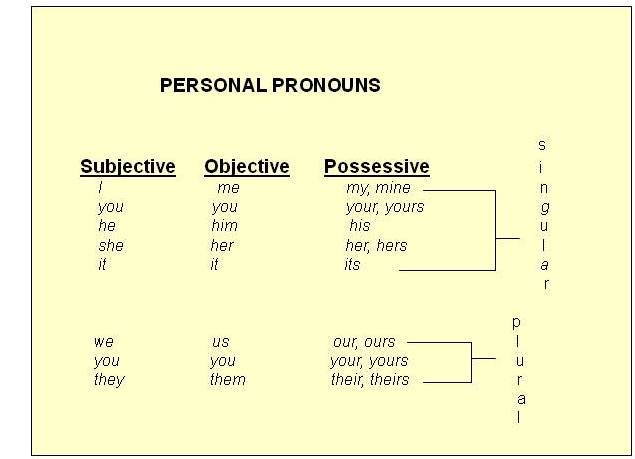
You should study these pronouns and know which ones belong
to which case.
Usually, using correct pronoun case is
perfectly natural.
Example:

You would not make these errors:
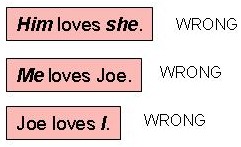
Now that you understand that pronoun case means using
correct personal pronoun forms, the rest of the unit
will focus on some “tricky” pronoun case situations and show you some helpful
hints for correct pronoun case in these situations.
Personal Pronouns as Subjects
It is rather simple to use the correct subject
pronoun under simple subject circumstances.
Example:

Sometimes, however, a sentence may have a compound
subject.
A compound subject occurs when there are two
or more subjects joined by and, but, or or.
Example:

In such an instance, you may wish to substitute a pronoun
for one or more of the noun subjects. BE CERTAIN TO USE SUBJECTIVE
PRONOUNS ONLY!
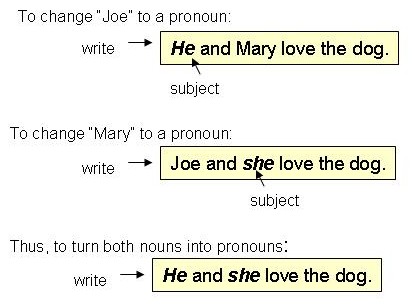
Do not fall into the trap of using objective case
pronouns when subject pronouns are needed.
Examples:

Even though you sometimes hear differently, a subjective pronoun is needed to substitute for a subject
noun.
HELPFUL HINT: If you are at all confused about
which case to use, try this: cover the rest of the subject EXCEPT for that part
you want to change to a pronoun. Then see which pronoun case sounds correct.
Example:
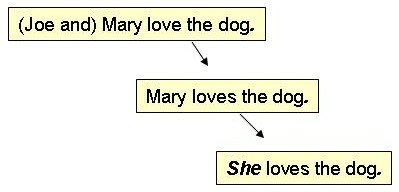
Thus, she is the correct
pronoun to use in place of Mary.
PERSONAL PRONOUNS WITH NOUN SUBJECTS
You must also remember to use subjective case pronouns when
a pronoun is used along with a noun subject.
Example:

It is incorrect in this instance to use
us,
the objective pronoun.

Again, as with compound subjects, you can simply cover up
the rest of the subject to see which pronoun sounds correct.

Notice how utterly incorrect the following sounds.

ONE FINAL NOTE about pronouns used as subjects: Do
NOT use the “self” pronouns (myself, yourself, herself, etc.) as
subjects.

To
avoid making this mistake, again block out the rest of the subject and see how
the pronoun sounds by itself.

In this instance, the correct pronoun to use is I.

The “self” pronouns, called reflexive / intensive
pronouns, can be used ONLY to reflect back to the subject or to
intensify the subject. In other words, they must follow a subject
that means to the same as they do.
Examples:
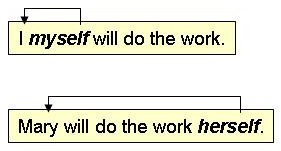
Personal Pronouns as Subjective Complements
Finally, you must use a subjective case pronoun
when the pronoun functions as a subjective complement.
What is a subjective complement?
A subjective complement
answers the question who or what after a form of the
verb to be. A
subjective complement completes the subject.
Or, in other words, a subjective complement means the same
as the subject but follows the verb.
Example:

Doctor
means the same as the subject here – it completes the subject.
Because the subjective complement is the same as the
subject, you should use a subject pronoun.
Imagine that you have been asked to pick a suspect out of a
police line-up. Recognizing the man who robbed you, you point to him and
say,

To see if this sentence has a subjective complement,
ask yourself, “The third man is who or what?” The answer is
robber.

Therefore, “robber”
is the subjective complement.
You may, however, want to use a personal pronoun in place
of “robber.”
Use a subjective case pronoun.


Do
NOT say

Subjective Case Pronouns – Brief Review
The subject pronouns are I, we, you, he, she, it,
they.

Link to Exercise 1
The
next 3 sections will consider when to use the objective case pronouns.

Personal Pronouns as Direct Objects
Like the subjective complement, the direct object answers
“whom” or “what” after the verb. Unlike the subjective complement, however, the
direct object follows an action verb (not a verb of being) and receives
the action. A direct object does NOT complete the subject
or equal the subject.
Example:


Rule: Determine the direct object by asking
whom or what after the action verb in a sentence.
Perhaps you may wish to substitute a pronoun for the direct
object, Martha.
Simply choose the appropriate (sex and number) object
pronoun.

Sometimes a sentence may have a compound direct object (2
objects joined by and, but, or or).
Example:

You may wish to change one of the noun direct objects to a
pronoun.
To do this, follow the same procedure you did with the
compound subject situation:
Block out the part of the compound
object you do NOT wish to change and choose the pronoun that sounds correct for
the remaining direct object.
Example:
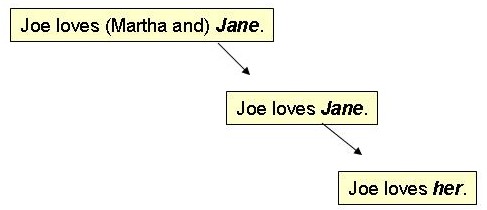
Thus, her is the correct pronoun to use
in place of Jane.

As with subject situations, remember to use an objective case pronoun when a pronoun is used along with a noun direct object.Example:
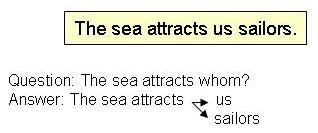
It is incorrect in this instance to use we,
the subjective pronoun.

Here again, as with compound direct objects, if you
are at all confused, simply blank out the noun part of the direct object and see
which pronoun sounds correct.

Therefore,
the correct sentence is

Finally, do not use a reflexive / intensive pronoun
as direct object (myself, yourself, herself, himself, itself, ourselves,
yourselves, themselves) UNLESS there is a personal pronoun or noun preceding
it that it can intensify or refer back to.

Remember:
Use a reflexive / intensive pronoun only when you see a noun or pronoun coming
before it that it will refer back to (for example, me myself;
Jack himself; them themselves).
Link to Exercise 2
Personal Pronouns Used As Indirect Objects
A sentence with a direct object may also have an indirect object.
An indirect object is a noun or
pronoun that
answers the question to whom
or to what
OR for whom
or for what
after an action verb. It always sits between the verb and the direct object.
NOTE: The word
to or for is understood
with an indirect object - not stated.
Example:

Question: Mary gave a present
to whom?
Answer: Joe
Therefore, Joe is the indirect object in this sentence.
Another Example:

Question: Joe gave a party for whom?
Answer: Mary
Therefore, Mary is the indirect object in this sentence.
Determine the indirect object by asking
to whom/what or for whom/what after the action verb in a sentence.
RULE: A sentence with an indirect object will
ALWAYS have a direct object as well.
To substitute a pronoun for the indirect object, Mary,
in the 2nd example, simply choose the appropriate objective
pronoun.

However, sometimes a sentence may have a compound
indirect object (two or more indirect objects joined by and,
but, or or).
Example:

To change one of the indirect object nouns to a pronoun,
use the same guidelines you used for compound subjects and compound direct
objects: block out the part of the indirect object you do NOT wish to change and
choose the pronoun that sounds correct for the remaining indirect object.
Example:
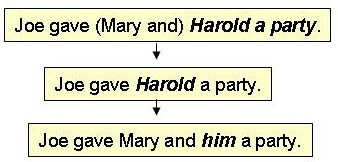
Thus, him is the correct pronoun to use in
place of Harold.

You must also remember to use an objective case
pronoun when a pronoun is used along with a noun indirect object.
Example:


If you are confused about which pronoun to choose, block
out the rest of the indirect object to see which pronoun sounds correct.

Thus,
the correct sentence is


Link to Exercise 3
Personal Pronouns as Objects of Prepositions
A sentence containing a preposition will automatically
contain an object for that preposition.
An object of a preposition is a noun or
pronoun following a preposition that answers whom or what after the
preposition.
Look over this list of the most frequently used
prepositions.
Make yourself familiar with them!
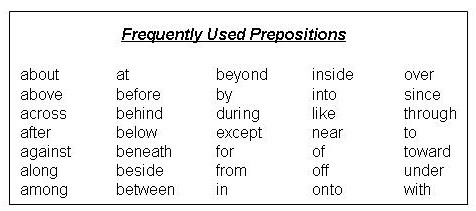
RULE: Prepositions ALWAYS begin prepositional
phrases.
Examples:

Each prepositional phrase contains a noun object of the preposition (o.p.).
Look at this prepositional phrase.

To determine the o.p., ask whom or what
after the preposition.


Usually, it is not difficult to choose the correct
objective pronoun.
Sometimes, however, a preposition may have more than one
object: a compound object (two objects of a preposition joined by and,
but, or or).
Example:

In this example, both nouns – woman and
man –
are objects of the preposition near. Joined by and,
they are compound objects of the preposition.
To change one prepositional object to a pronoun, follow the
same procedure you did with other compound elements in this unit:
1.
Block out the noun o.p. you do not wish to change to a pronoun.
2.
Choose the pronoun that sounds correct for the remaining o.p. --- the
one you wish to change to a pronoun.
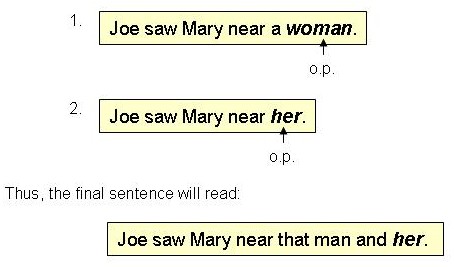
To change both objects (man and
woman), simply follow the same procedure with that man.
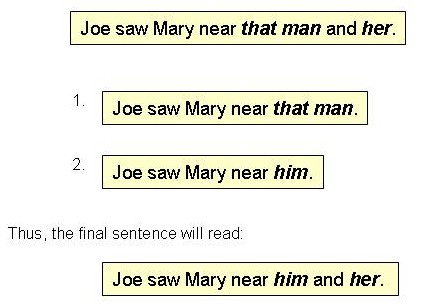
**NOTE
CAREFULLY: When followed by compound pronoun objects, the
preposition between offers special problems.
Sometimes you will hear between INCORRECTLY
followed by one or more subjective pronouns.
Example:

The pronoun I is incorrect here. Why?
I is incorrect because it is a subject
pronoun being used in an object situation: object of the preposition
between.
Do not let between fool you. Always use
objective case pronouns as objects of between – or any other
preposition.
 Me is an objective case pronoun; therefore,
it is the correct one to use as the object of the preposition between.
Here are more examples using between.
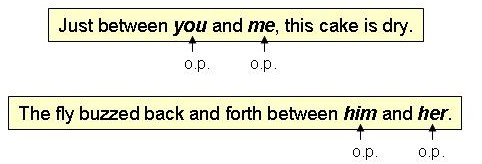
Although at first the correct choice may not “sound” right,
always choose the objective form pronoun to act as an object of a
preposition (o.p.) after the preposition between.
As with subjects, direct objects, and indirect objects,
sometimes a pronoun may be used next to a noun object of a preposition (but not
as compound).
Example:


If you are confused about which pronoun to choose next to
an object of the preposition, block out the rest of the object of the
preposition and see which
pronoun sounds correct.
Example:


NOTE: Finally, the
"self" pronouns can
be used as objects of prepositions ONLY when they clearly refer back to a noun
or pronoun preceding them.
Example:

In this sentence, himself refers back to
baby and is, therefore, correct.
Link to Exercise 4
Now that you have learned about the major subject / object
positions in sentences and the correct pronoun case to use in each, you are
ready to consider a few more instances which require special attention.
Correct Use of
Who and Whom
Choosing between who or whom is
often confusing.
Here are some “tricks” to help you know whether to use
who or whom.
Like he, they, etc., who
is a subject pronoun (subjective case).
Therefore, who should be used whenever it
will do the job of subject or subject complement in a sentence.
Example:

Try using a subject pronoun like he in place
of who.

If the substituting sounds all right, then use the
subjective form who.
Whom, on the other hand, is an object
pronoun (objective case). Therefore, it should be used whenever it will do the
job of direct object, indirect object, or object of preposition.
Example:

Try using an object pronoun like him in place
of whom.

Helpful Hint: Try substituting he for
who and him for whom when you are
determining which word is the correct one to use.
Sometimes, however, sentences can be more complicated than
the examples given so far:

Which is correct – who or whom?
In such an instance, you must see the sentence as
two
distinct parts and determine how who / whom is functioning in
its own distinct section of the sentence.

“________ took the flowers.”
Since who / whom took the flowers needs a subject, then
the subject pronoun – who – is the correct one to use.
The
sentence reads correctly as

Here is another example of a sentence with two
distinct parts. Choose who or whom depending on how
it is functioning in its own distinct section.
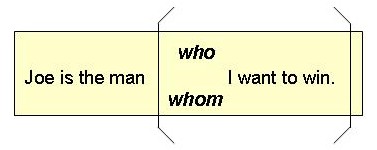
The clause who / whom I want to win already has a
subject: I.
A closer look inside the clause shows that it really
means I want who / whom to win.
Thus, who / whom will function as a direct
object answering the question whom or what after the verb want.
Therefore, the choice should be the object form.
Test your choice with the objective case pronoun him.

Thus,
the sentence reads correctly as

REMEMBER:
1.
If you can substitute he, use who . . . the
subject pronoun.
2.
If you can substitute him, use whom . . . the
object pronoun.
3.
Determine the correct choice by deciding how the pronoun (who /
whom) is being used in its own clause.
Link to Exercise 5
Comparisons
Often we compare one thing, quality, or person to another
by using either than or as . . . as to form the comparison. When we are
using nouns in the comparison, there is no need to worry about choosing a
“correct” noun.
Examples:

The difficulty arises when a pronoun is substituted
for the noun coming after the comparison. You must choose between subjective
and objective forms.
Here is a helpful hint to aid you in choosing correct
pronoun form.
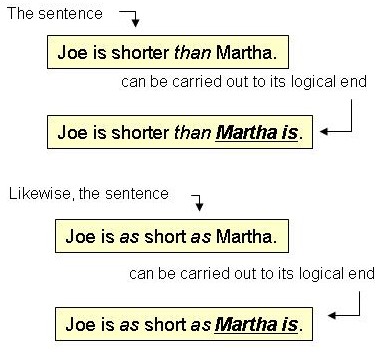
To choose the correct pronoun for Martha,
simply carry out the sentence to its logical conclusion.
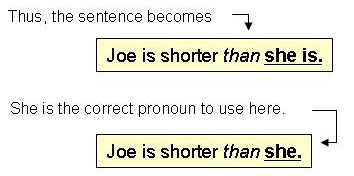
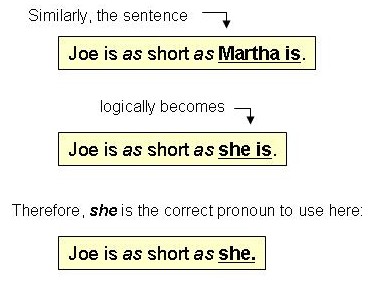
In both instances, the correct pronoun can be
determined by “completing” the idea of the sentence. In the examples above, a
subject pronoun (she) is the correct one.
However, at other times, an object pronoun will be correct.
Examples
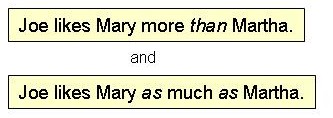
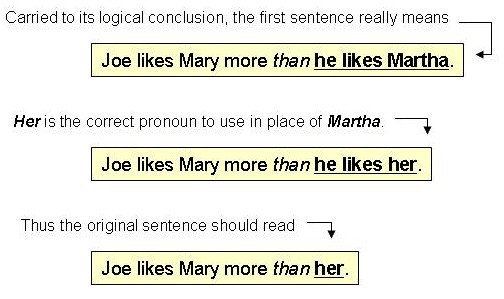
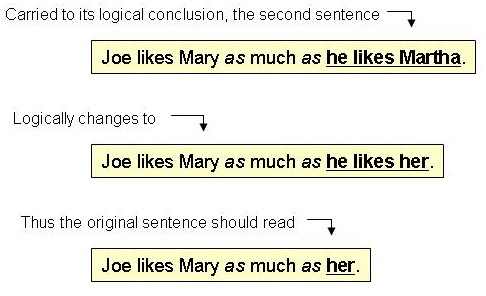
As shown in these four examples using comparisons,
choose the pronoun that fits the intended meaning of the sentence.
Link to Exercise 6
Pronouns
with verbals
Finally, you must choose the correct pronoun case when you
use pronouns with verbals.
A verbal is a verb form doing the job of a
noun or adjective.
There are two kinds of verbals used with pronouns – gerunds and participles.
#1 GERUND – Gerunds end in –ing and act like
nouns.
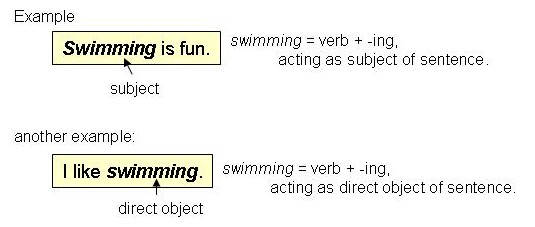
When nouns or pronouns precede gerunds in sentences, USE
THE POSSESSIVE CASE.
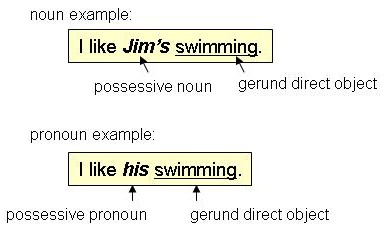
Sometimes sentences can be more complicated.

It would be WRONG to use the subjective or objective
pronoun form.
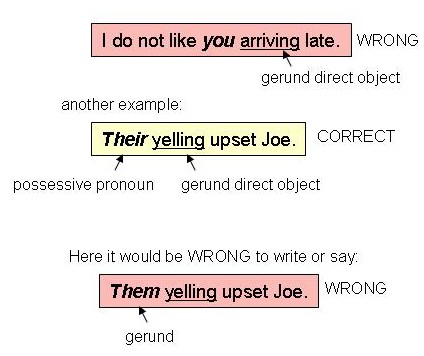
RULE: When a personal pronoun precedes a gerund,
use POSSESSIVE case.
Sometimes, however, an –ing verbal will not require
a possessive pronoun. Not all –ing verbals are gerunds.
Example:

In this example, the direct object is
them. Eating
is functioning as an adjective, not a noun. Therefore, eating
is not a gerund.
An –ing verbal that acts like an adjective (i.e., it
modifies a noun or pronoun) is called a participle.
Review:

Link to Exercise 7
Link to the Post Test
|